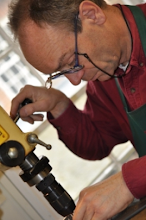I just completed my first clock with a fusee. It was a rather dilapidated English dial timepiece. Once I cleaned and repaired it, it came into its own beauty, though, even after agreeing with the client to leave the dial in the worn state it was in. So a real conservation project.
 |
| English dial timepiece with fusee inside |
It was clear to me that the mainspring had seen better days and remembering my West Dean tutor's helpful rule:
when a mainspring's diameter is equal to or less than twice the diameter of its barrel, then replace the mainspring,
made me decide to replace the mainspring. I ended up with a stainless steel mainspring supplied by Cousins. It was the first time that I had to apply my tutor's rule, so my expectations were high of the performance of this new spring after I had put it into its barrel and put a new steel wire onto the barrel and fusee.
I should have been for warned, though. Putting this stainless steel spring into its barrel was a tour de force! After several tries with the first aid box placed close to me, I managed to get the mainspring into the barrel. Once the barrel was in the clock, I tried winding it. It proved impossible to wind the clock more than two half turns. I just did not have the power in my hands to do more. A blessing in itself, because otherwise I might have broken the key, the steel wire or both (at least it felt like that).
Luckily, in the same week, the Annual General Meeting of the Antiquarian Horological Society was about to take place with this year's focus on Dutch clocks from the 17th and 18th century. In other words, I had to be there. Two of my West Dean classmates were quick to solve my mainspring problem at this meeting by recommending I try a carbon steel spring from Clockspares. Carbon steel springs having much less power than the stainless steel variety. This solved my problem well. It even allowed me to put gut line on the barrel rather than steel wire.
This whole saga taught me to include mainspring data in my written client reports. And with further help from this informative website http://www.abbeyclock.com/usmsp.html I now have a much better handle on mainsprings.











